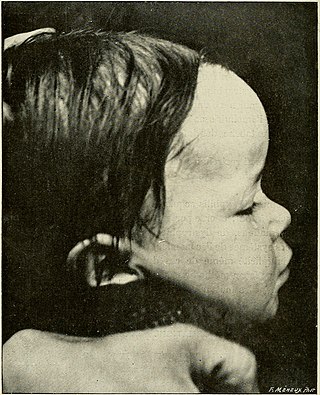
Macrocephaly is a condition in which circumference of the human head is abnormally large. It may be pathological or harmless, and can be a familial genetic characteristic. People diagnosed with macrocephaly will receive further medical tests to determine whether the syndrome is accompanied by particular disorders. Those with benign or familial macrocephaly are considered to have megalencephaly.

Brachycephaly is the shape of a skull shorter than average in its species. It is perceived as a cosmetically desirable trait in some domesticated dog and cat breeds, notably the pug and Persian, and can be normal or abnormal in other animal species.

Turricephaly is a type of cephalic disorder where the head appears tall with a small length and width. It is due to premature closure of the coronal suture plus any other suture, like the lambdoid, or it may be used to describe the premature fusion of all sutures. It should be differentiated from Crouzon syndrome. Oxycephaly is a form of turricephaly where the head is cone-shaped, and is the most severe of the craniosynostoses.

A unibrow is a single eyebrow created when the two eyebrows meet in the middle above the bridge of the nose. The hair above the bridge of the nose is of the same color and thickness as the eyebrows, such that they converge to form one uninterrupted line of hair.

Walker–Warburg syndrome (WWS), also called Warburg syndrome, Chemke syndrome, HARD syndrome, Pagon syndrome, cerebroocular dysgenesis (COD) or cerebroocular dysplasia-muscular dystrophy syndrome (COD-MD), is a rare form of autosomal recessive congenital muscular dystrophy. It is associated with brain and eye abnormalities. This condition has a worldwide distribution. Walker-Warburg syndrome is estimated to affect 1 in 60,500 newborns worldwide.

Congenital muscular dystrophies are autosomal recessively-inherited muscle diseases. They are a group of heterogeneous disorders characterized by muscle weakness which is present at birth and the different changes on muscle biopsy that ranges from myopathic to overtly dystrophic due to the age at which the biopsy takes place.

3C syndrome is a rare condition whose symptoms include heart defects, cerebellar hypoplasia, and cranial dysmorphism. It was first described in the medical literature in 1987 by Ritscher and Schinzel, for whom the disorder is sometimes named.

Gillespie syndrome, also called aniridia, cerebellar ataxia and mental deficiency, is a rare genetic disorder. The disorder is characterized by partial aniridia, ataxia, and, in most cases, intellectual disability. It is heterogeneous, inherited in either an autosomal dominant or autosomal recessive manner. Gillespie syndrome was first described by American ophthalmologist Fredrick Gillespie in 1965.

COACH syndrome, also known as Joubert syndrome with hepatic defect, is a rare autosomal recessive genetic disease. The name is an acronym of the defining signs: cerebellar vermis aplasia, oligophrenia, congenital ataxia, coloboma and hepatic fibrosis. The condition is associated with moderate intellectual disability. It falls under the category of a Joubart Syndrome-related disorder (JSRD).

SRD5A3-CDG is a rare, non X-linked congenital disorder of glycosylation (CDG) due to a mutation in the steroid 5 alpha reductase type 3 gene. It is one of over 150 documented types of Congenital disorders of Glycosylation. Like many other CDGs, SRD5A3 is ultra-rare, with around 38 documented cases in the world.

Hall-Riggs syndrome is a rare genetic disorder that causes neurological issues and birth defects. People with Hall-Riggs syndrome usually have skeletal dysplasia, facial deformities, and intellectual disabilities. Only 8 cases from 2 families worldwide have been described in medical literature. It is an autosomal recessive genetic disorder, meaning both parents must carry the gene in order for their offspring to be affected.

Ventricular extrasystoles with syncopal episodes-perodactyly-Robin sequence syndrome is a rare autosomal dominant genetic disorder characterized by cardiofaciodigital anomalies occurring alongside Pierre Robin sequence. Additional features include abnormal sense of smell, camptodactyly, recurrent joint dislocations, and short stature. Around 6 to 12 cases have been described in medical literature.

High anterior hairline is a dysmorphic feature in which the frontal hairline which defines the top and sides of the forehead is unusually high. This can mean that either the distance between the trichion (hairline) and glabella is more than 2 SD above the mean, or that this distance is apparently (subjectively) increased.

Flat forehead is a dysmorphic feature in which the surface of the forehead is unusually flat.
Cardiocranial syndrome, Pfeiffer type is a rare multiple disorder syndrome characterized by congenital heart defects, sagittal craniosynostosis, and severe developmental delay. The condition has been reported in less than 10 patients worldwide.














